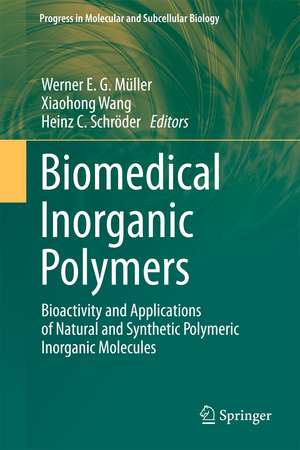Biomedical Inorganic Polymers: Bioactivity and Applications of Natural and Synthetic Polymeric Inorganic Molecules: Progress in Molecular and Subcellular Biology, cartea 54
Editat de Werner E.G. Müller, Xiaohong Wang, Heinz C. Schröderen Limba Engleză Hardback – 27 ian 2014
| Toate formatele și edițiile | Preț | Express |
|---|---|---|
| Paperback (1) | 1095.36 lei 6-8 săpt. | |
| Springer Berlin, Heidelberg – 23 aug 2016 | 1095.36 lei 6-8 săpt. | |
| Hardback (1) | 1100.30 lei 6-8 săpt. | |
| Springer Berlin, Heidelberg – 27 ian 2014 | 1100.30 lei 6-8 săpt. |
Din seria Progress in Molecular and Subcellular Biology
- 18%
 Preț: 1115.46 lei
Preț: 1115.46 lei - 18%
 Preț: 1403.04 lei
Preț: 1403.04 lei - 18%
 Preț: 1112.30 lei
Preț: 1112.30 lei - 18%
 Preț: 1117.03 lei
Preț: 1117.03 lei - 18%
 Preț: 1222.49 lei
Preț: 1222.49 lei - 18%
 Preț: 1382.21 lei
Preț: 1382.21 lei - 18%
 Preț: 1232.26 lei
Preț: 1232.26 lei - 18%
 Preț: 1222.80 lei
Preț: 1222.80 lei - 24%
 Preț: 1045.93 lei
Preț: 1045.93 lei - 18%
 Preț: 956.50 lei
Preț: 956.50 lei -
 Preț: 387.20 lei
Preț: 387.20 lei - 15%
 Preț: 639.73 lei
Preț: 639.73 lei - 15%
 Preț: 633.19 lei
Preț: 633.19 lei - 15%
 Preț: 634.18 lei
Preț: 634.18 lei - 15%
 Preț: 634.00 lei
Preț: 634.00 lei - 15%
 Preț: 640.24 lei
Preț: 640.24 lei - 5%
 Preț: 714.27 lei
Preț: 714.27 lei - 15%
 Preț: 634.32 lei
Preț: 634.32 lei - 15%
 Preț: 637.28 lei
Preț: 637.28 lei - 15%
 Preț: 637.78 lei
Preț: 637.78 lei - 15%
 Preț: 637.28 lei
Preț: 637.28 lei - 15%
 Preț: 649.06 lei
Preț: 649.06 lei -
 Preț: 387.75 lei
Preț: 387.75 lei - 18%
 Preț: 1220.75 lei
Preț: 1220.75 lei - 18%
 Preț: 1224.99 lei
Preț: 1224.99 lei - 18%
 Preț: 946.87 lei
Preț: 946.87 lei - 15%
 Preț: 633.35 lei
Preț: 633.35 lei - 18%
 Preț: 944.36 lei
Preț: 944.36 lei -
 Preț: 387.96 lei
Preț: 387.96 lei - 15%
 Preț: 633.02 lei
Preț: 633.02 lei - 15%
 Preț: 640.88 lei
Preț: 640.88 lei - 5%
 Preț: 720.10 lei
Preț: 720.10 lei
Preț: 1100.30 lei
Preț vechi: 1158.20 lei
-5% Nou
Puncte Express: 1650
Preț estimativ în valută:
210.57€ • 228.65$ • 176.88£
210.57€ • 228.65$ • 176.88£
Carte tipărită la comandă
Livrare economică 23 aprilie-07 mai
Preluare comenzi: 021 569.72.76
Specificații
ISBN-13: 9783642410031
ISBN-10: 3642410030
Pagini: 300
Ilustrații: X, 303 p. 91 illus., 50 illus. in color.
Dimensiuni: 155 x 235 x 25 mm
Greutate: 0.57 kg
Ediția:2013
Editura: Springer Berlin, Heidelberg
Colecția Springer
Seria Progress in Molecular and Subcellular Biology
Locul publicării:Berlin, Heidelberg, Germany
ISBN-10: 3642410030
Pagini: 300
Ilustrații: X, 303 p. 91 illus., 50 illus. in color.
Dimensiuni: 155 x 235 x 25 mm
Greutate: 0.57 kg
Ediția:2013
Editura: Springer Berlin, Heidelberg
Colecția Springer
Seria Progress in Molecular and Subcellular Biology
Locul publicării:Berlin, Heidelberg, Germany
Public țintă
ResearchCuprins
Chemical, biochemical and biological behaviors of vanadate and its oligomers.- Structural Characterization of Inorganic Biomaterials.- Enzymes of Inorganic Polyphosphate Metabolism.- Polyoxometalates Active against Tumors, Viruses and Bacteria.- Modeling Biosilicification at Subcellular Scales.- Cell reactivity to different silica.- Bioactive Poly(arsenic) Compounds.- Biogenic inorganic polysilicates (bio-silica): formation and biomedical applications.- Inorganic polymers: Morphogenic inorganic biopolymers for rapid prototyping chain.- Inorganic polyphosphates: biologically active biopolymers for biomedical applications.
Textul de pe ultima copertă
This book summarizes the present state of knowledge on a number of inorganic polymers with respect to their potential biomedical applications. In recent years, inorganic polymers have attracted much attention in nano-biomedicine, in particular in the areas of regenerative medicine and drug delivery. The growing interest in these polymers has been further accelerated by the development of new synthetic and analytical methods in the field of nanotechnology and nanochemistry. Examples of biomedical inorganic polymers that have been proven to exhibit biomedical effects and/or have been applied in preclinical or clinical trials are polysilicate / silica glass (such as naturally formed “biosilica” and synthetic “bioglass”) and inorganic polyphosphate. Some biomedical inorganic polymers have already been applied e.g. as “bioglass” for bone repair and bone tissue engineering, or are used in food processing and in dental care (inorganic polyphosphates).
However, there are a number of further biological and medicinal properties of these polymers that have been elucidated in the last few years but not yet been applied for treatment of humans. In addition to polysilicates and polyphosphate, there are a series of other inorganic polymers including polyarsenate and polyvanadate, the biological / biomedical properties of which have been only marginally studied so far. Moreover, the combined application of inorganic polymers and organic polymeric molecules (formation of organic-inorganic hybrid materials) provides a variety of new materials with novel property combinations and diverse applications in nanomedicine.
However, there are a number of further biological and medicinal properties of these polymers that have been elucidated in the last few years but not yet been applied for treatment of humans. In addition to polysilicates and polyphosphate, there are a series of other inorganic polymers including polyarsenate and polyvanadate, the biological / biomedical properties of which have been only marginally studied so far. Moreover, the combined application of inorganic polymers and organic polymeric molecules (formation of organic-inorganic hybrid materials) provides a variety of new materials with novel property combinations and diverse applications in nanomedicine.
Caracteristici
Summarizes the state-of-the art in this rapidly growing field Comprehensively reviews the potential biomedical applications of inorganic polymers Written by eminent experts Includes supplementary material: sn.pub/extras












